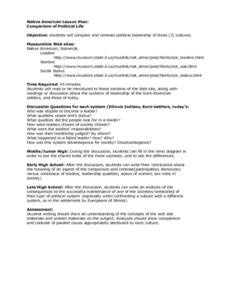Curated OER
Scribbleboy
Fifth graders are introduced to the text, SCRIBBLEBOY, discussing the cover page for clues to the genre. They discuss the ordinary surroundings contrasted by the graffiti and the words and phrases used to provide information about the...
California Academy of Science
Make your own Antelope Horns!
What are those horns for anyway? Little ones discuss the shape, texture, and purpose of horns found on animals such as the deer and antelope. They then pair up and make their own set of antelope horns to wear while visiting a local...
Curated OER
Sonnet Explication
Learners analyze close readings of poems, looking up words in the dictionary, and discussing the major parts of dictionary definitions, including word origin and parts of speech. They examine sonnets, then compare/contrast their findings.
Curated OER
Allocating Energy from a Photovoltaic System
How much electricity do you use in a day? Physics fanatics calculate their energy use by consulting a chart of the watts required to run typical household appliances. They compare power to amounts of electric energy used or generated....
Curated OER
Feeding in the Flow
The National Oceanic and Atmospheric Administration (NOAA) has developed a tremendous library of ocean-themed lessons that can be used in a variety of science settings. "Feeding in the Flow" is one of those activities; Its focus is on...
Curated OER
Oral Presentation
Practice public speaking in this oral presentation lesson. Middle schoolers list the characteristics of a powerful speaker. They watch a video of two speakers, compare them and discuss the qualities of a good speech. Afterwards, they...
Curated OER
Ready, Set, Tech
Students oabsrve pictures of a Brachiosaurus and an Apotosaurus. They discuss how features are similar, and different. Students list data in a Venn diagram. They visit book mark websites. Students write three facts on how to saurpods...
Curated OER
History of Japan
Students research the mythological and factual founding of early Japan. They compare and contrast the two accounts. As an assessment activity, they fill out a chart that compares and contrasts the facts and myths surrounding Japanese...
Curated OER
Dam-it? I Just Don't Know!?!
Eighth graders analyze two different large dams: The Hoover Dam and the Three Gorges Dam. They compare and contrast the two dams.
Curated OER
Sort It Out and Match It Up
Students identify objects that are the same shape and size. They compare and contrast attributes of two-and three-dimensional objects using appropriate vocabulary. Pupils justify an extension of a geometric pattern to explain what was...
Curated OER
Which Shall We Pick?
Students compare and contrast the value of different organizations in their community. They listen to subjective and objective perspectives to make a decision. They use the decision-making process to decide which organization needs...
Curated OER
Tribal Traits
Fourth graders will analyze the similarities and differences between early Texas Indian tribes, compare and contrast two tribes, select to which tribe they would rather belong, and determine their location today.
Curated OER
Burial Practices and Memorials
Young scholars compare and contrast burial practices in ancient Egypt, the former Soviet Union, and the United States.
Curated OER
Pros and Cons of Advertising
Twelfth graders compare and contrast television commercials. They write paragraphs explaining how different company commercials for the same product can confuse consumers.
Curated OER
When You Put It All Together!
Students review information from variety of news sources found on the Internet, and compare and contrast the information.
Curated OER
Plants in Texas: Then and Now
Seventh graders discuss continuity and change, identify various plant materials, and compare and contrast ways in which early people used plants in Texas in prehistoric times with ways that modern man in Texas uses plants today.
Curated OER
Japan: perception, images, myths
Learners compare and contrast American and Japanese social and cultural values, attitudes, characteristics, and patterns of behavior. They identify problems that North Americans have in doing business in Japan. They appreciate the...
Curated OER
Nonprofits?
Students distinguish the nonprofit sector from the for-profit sector. They define and give examples of nonprofit organizations, name and illustrate examples in the local community and compare and contrast nonprofits to the for-profit...
Curated OER
Comparison of Political Life
Young scholars research and compare and contrast the political leadership of three cultures.
Curated OER
Female Artists
Students listen to excerpts from "History of Women Artists for Students" and discuss the artwork of three artists. They compare and contrast the styles of art and investigate a CD-Rom of famous artists.
Curated OER
Arkansas Democrat-Gazette Past and Present
Students use a Venn diagram to compare and contrast the Arkansas Democrat-Gazette as it was in the past and as it is today.
Curated OER
It's All in the Air
Young scholars examine air quality. They test the air for visible pollutants by observing jars for one week and compare and contrast the data they collect. After comparing and contrasting the data, they graph the results of pollution...
Curated OER
Author Study - Gerald McDermott
Students listen to story written by author Gerald McDermott, compare and contrast other stories they have read written by same author, create Venn diagrams showing similarities and differences among stories, and determine which story is...
Curated OER
Hawks Migrate
Students examine the types of hawks found in Illinois and compile a list of them. Using different species of hawks, they compare and contrast their characteristics. They work together to create their own hawk model for the classroom.

























